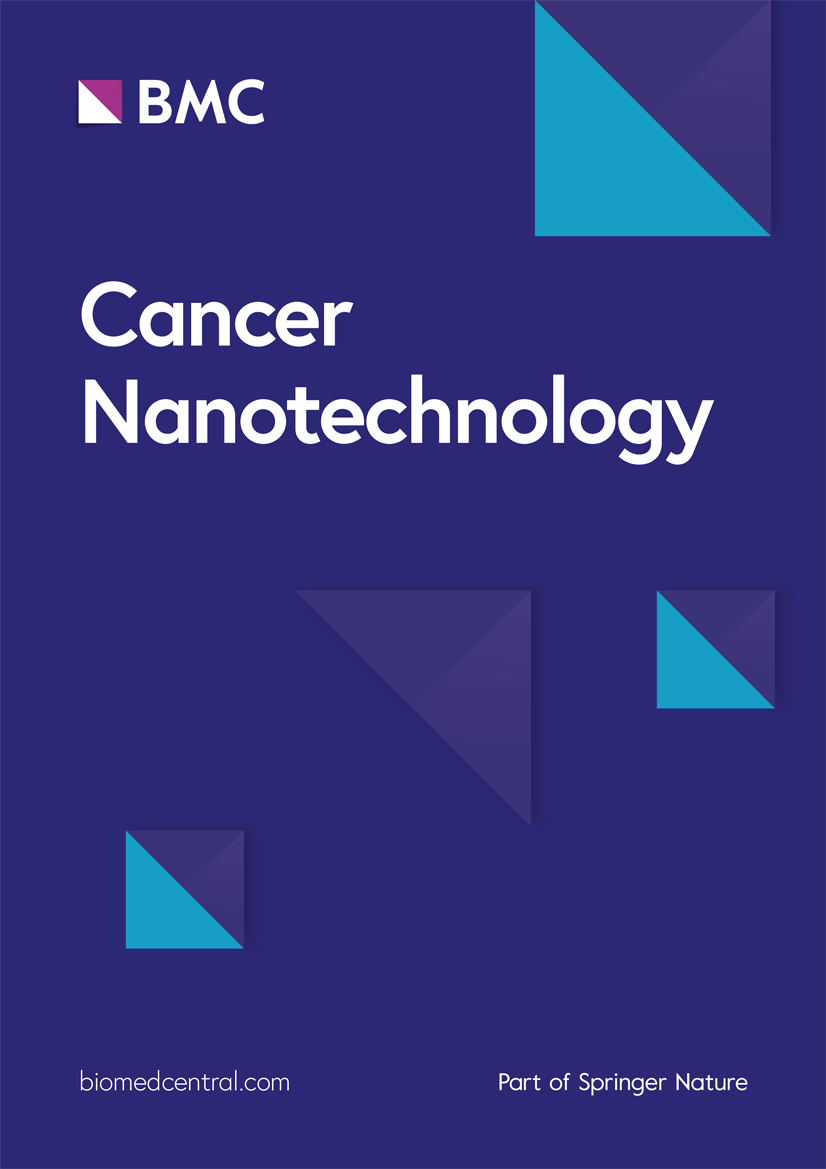绿色熟练合成无毒的铜和钴氧化物纳米复合材料具有多方面的生物活性
IF 4.8
2区 工程技术
Q2 NANOSCIENCE & NANOTECHNOLOGY
引用次数: 0
摘要
摘要背景在当今时代,我们面临着不同的健康问题,主要涉及微生物的耐药性以及癌细胞的耐药性。此外,我们还面临着控制氧化应激和蚊源性登革热、疟疾、基孔肯雅热等虫源性疾病的问题。在这项研究中,我们揭示了黄斑黄芪粘液在绿色合成粘液介导的氧化铜生物纳米复合材料(SM-CuONC)和氧化钴生物纳米复合材料(sm - co3o4nc)中的潜力。本文对合成的生物纳米复合材料进行了紫外可见光谱、x射线衍射(XRD)、场发射扫描电镜(FESEM)、透射电镜(TEM)、能量色散x射线分析(EDAX)和x射线光电子能谱(XPS)等理化表征。采用孔扩散法、MTT法、钼磷法和杀蚊法测定了两种生物纳米复合材料的抗菌活性、抗癌活性和抗氧化活性。结果利用黄颡鱼黏液成功合成了SM-CuONC和sm - co3o4nc。FESEM和TEM数据表明,两种纳米复合材料均形成了准球形的纳米颗粒,平均粒径约为18 nm。EDAX峰证实了分析样品中铜和钴元素的存在。x射线衍射分析证实了CuO和co3o4的结晶性质。抑菌实验结果表明,SM-CuONC对大肠杆菌NCIM 2065和烟曲霉NCIM 902的抑菌活性最高,分别为2.36±0.31和2.36±0.59 cm。浓度为60µg/孔。在20µg/孔浓度下,SM-CuONC对人结肠癌(HCT-15)、宫颈癌(HeLa)和乳腺癌(MDA-MB-231)细胞株的杀伤率分别为68.66±3.72、62.66±3.61和71.00±2.36%,sm - co3o4nc对人结肠癌(HCT-15)、宫颈癌(HeLa)和乳腺癌(MDA-MB-231)的杀伤率分别为61.00±3.57、72.66±4.50和71.66±4.22%。两种纳米复合材料均表现出较好的抗氧化活性。在50µg/ml浓度下,SM-CuONC的总抗氧化活性最高,分别为55.33±3.72 mM /µg, sm - co3o4ns的总抗氧化活性最高,分别为52.00±3.22 mM /µg。在40 ~ 50 mg/l的浓度范围内,两种生物纳米复合材料均表现出100%的灭蚊活性。在细胞毒性研究中,我们注意到在5µg/孔浓度下,SM-CuO和sm - co3o4ncs悬浮液对正常(L929)细胞株的存活率超过97%。我们还研究了两种生物纳米复合材料对小麦的植物毒性。在本研究中,SM-CuONC和sm - co3o4nc分别以500 mg/l和250 mg/l的浓度处理种子时,种子萌发率达到100%。结论合成的SM-CuONC和sm - co3o4nc均具有较好的抗菌、抗癌、抗氧化和杀蚊潜能,可用于制药、卫生保健等领域,提高人类生活质量。本文章由计算机程序翻译,如有差异,请以英文原文为准。
Green adeptness in synthesis of non-toxic copper and cobalt oxide nanocomposites with multifaceted bioactivities
Abstract Background In the present era, we are facing different health problems mainly concerning with drug resistance in microorganisms as well as in cancer cells. In addition, we are also facing the problems of controlling oxidative stress and insect originated diseases like dengue, malaria, chikungunya, etc. originated from mosquitoes. In this investigation, we unfurled the potential of Achatina fulica mucus in green synthesis of mucus mediated copper oxide bio-nanocomposites (SM-CuONC) and cobalt oxide bio-nanocomposites (SM-Co 3 O 4 NC). Herein we carried out the physico-chemical characterization like UV–Vis spectra, X-ray diffraction (XRD), Field Emission Scanning Electron Microscopy (FESEM), Transmission electron microscopy (TEM), Energy Dispersive X-ray Analysis (EDAX) and X-ray photoelectron spectroscopy ( XPS) of as synthesized bio-nanocomposites. Both the bio-nanocomposites were tested for their potential as antimicrobial activity using well diffusion assay, anticancer activity by MTT assay, antioxidant activity by phosphomolybdenum assay and mosquito larvicidal activity. Results The results of this study revealed that, SM-CuONC and SM-Co 3 O 4 NC were synthesized successfully using A. fulica mucus. The FESEM and TEM data reveal the formation of nanoparticles with quasi-spherical morphology and average particle size of ~ 18 nm for both nanocomposites. The EDAX peak confirms the presence of elemental copper and cobalt in the analyzed samples. The X-ray diffraction analysis confirmed the crystalline nature of the CuO and Co 3 O 4 . The result of anti microbial study exhibited that, SM-CuONC showed maximum antimicrobial activity against Escherichia coli NCIM 2065 and Aspergillus fumigatus NCIM 902 which were noted as 2.36 ± 0.31 and 2.36 ± 0.59 cm resp. at 60 µg/well concentration. The result of anticancer activity for SM-CuONC was exhibited as, 68.66 ± 3.72, 62.66 ± 3.61 and 71.00 ± 2.36 percent kill, while SM-Co 3 O 4 NC exhibited 61.00 ± 3.57, 72.66 ± 4.50 and 71.66 ± 4.22 percent kill against Human colon cancer (HCT-15), Cervical cancer (HeLa), and Breast cancer (MDA-MB-231) cell lines, respectively, at 20 µg/well concentration. Both the nanocomposites also exhibited better antioxidant activity. Total antioxidant activity for SM-CuONC at 50 µg/ml concentration was found to be highest as 55.33 ± 3.72 while that of SM-Co 3 O 4 Ns was 52.00 ± 3.22 mM of ascorbic acid/µg respectively. Both bio-nanocomposites also exhibited 100% mosquito larvicidal activity at concentration ranging from 40 to 50 mg/l. During cytotoxicity study it is noted that at 5 µg/well concentration, SM-CuO and SM-Co 3 O 4 NCs suspension showed more than 97% viability of normal (L929) cell lines. We also studied phytotoxicity of both bio-nanocomposites on Triticum aestivum . In this study, 100% seed germination was observed when seeds are treated with SM-CuONC and SM-Co 3 O 4 NC at 500 mg/l and 250 mg/l concentration respectively. Conclusions This study concludes that in future as synthesized SM-CuONC and SM-Co 3 O 4 NC can be used in pharmaceutical, health care system for betterment and welfare of human life as both bio-nanocomposites exhibits better antimicrobial, anticancer, antioxidant and mosquito larvicidal potential.
求助全文
通过发布文献求助,成功后即可免费获取论文全文。
去求助
来源期刊

Cancer Nanotechnology
Pharmacology, Toxicology and Pharmaceutics-Pharmaceutical Science
CiteScore
5.20
自引率
1.80%
发文量
37
审稿时长
15 weeks
期刊介绍:
Aim:
Recognizing cancer as a group of diseases caused by nanostructural problems (i.e. with DNA) and also that there are unique benefits to approaches inherently involving nanoscale structures and processes to treat the disease, the journal Cancer Nanotechnology aims to disseminate cutting edge research; to promote emerging trends in the use of nanostructures and the induction of nanoscale processes for the prevention, diagnosis, treatment of cancer; and to cover related ancillary areas.
Scope:
Articles describing original research in the use of nanostructures and the induction of nanoscale processes for the prevention, diagnosis and treatment of cancer (open submission process). Review, editorial and tutorial articles picking up on subthemes of emerging importance where nanostructures and the induction of nanoscale processes are used for the prevention, diagnosis and treatment of cancer.
 求助内容:
求助内容: 应助结果提醒方式:
应助结果提醒方式:


